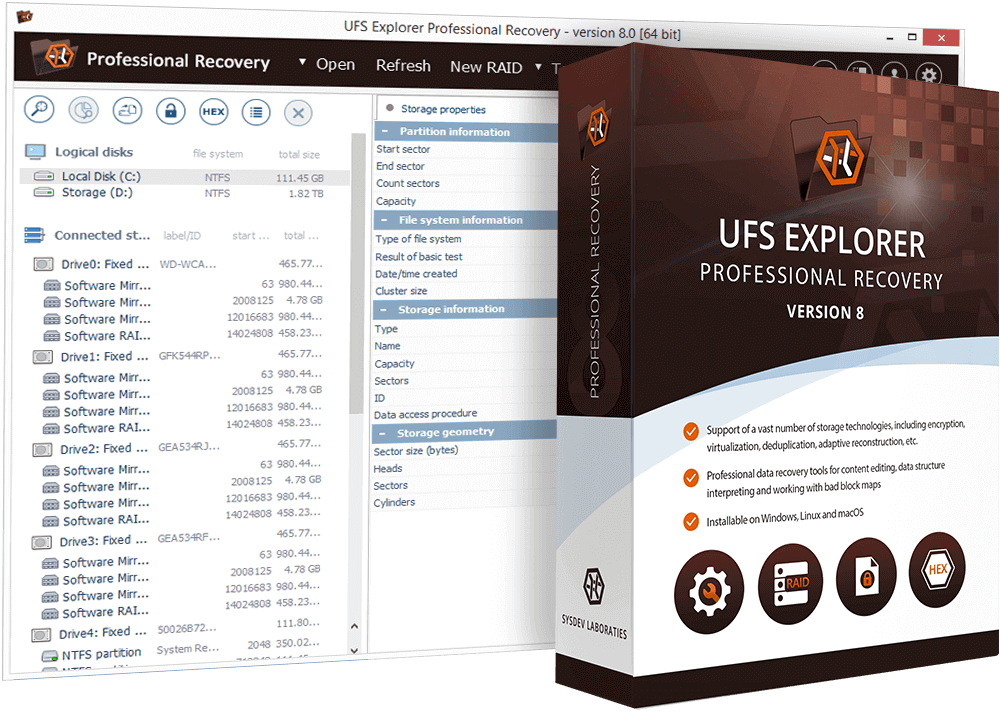The settings that are defined are saved in the appropriate user profile folder within the special “fix” document. The program does not save any information to the registry of the operating system as well as configuration files. When there are too many changes that are too, the program will ask to save the data in order to continue. If one operation takes more memory than the buffer to undo it can be carried out directly on the storage, without having the option of undoing it. Additionally, there are tools to fill gaps in data or more intricate byte-based transformations. Get More Softwares From Getintopc
Password 123
Ufs Explorer Professional Recovery
Start the program using its shortcut and then remove the application. If the correct data has been submitted, the application will be in the “Registered” mode immediately to take away the trial limitations. Other versions that are part of UFS Explorer can be installed together with UFS Explorer Professional Recovery. Do not install or download UFS Explorer on the same storage you lost your data. Don’t install or download the software onto the storage where you lost your data from. Purchase a license for the software and then enjoy working with it without restrictions.
Ufs Explorer Professional Recovery Features
The older and older versions of this program (Version 3.0 Version 4.9.2 up to Version 5.9) are available on the Legacy downloads page. The most current version of the software can be downloaded from the download page, accessible by clicking the link below.
The undesirable blocks that occur in the process of imaging are mapped out on a map, which is used in other data recovery procedures. UFS Explorer lets you create any RAID configuration using the virtual model to allow for future information access and recovery.
If a disk appears to have issues It is strongly suggested to create an image of the disk and then carry out any additional data recovery with the disc image. The “Open” option in the main menu is comprised of three subitems. Using them, you can open manually an image of a disk or virtual disk, an image made up of chunk files, and a block-based device, by providing its complete path. I’ll discuss next week with my IT manager to purchase a commercial license… I’m looking for a program to read the ext2, ext3, and raisers file systems on Windows machines, and retrieve the NTFS and fat disks off the workstations of users.

UFS Explorer Professional supports SCSI and SAS drives that use the non-standard size of sectors and converts sectors automatically to the traditional dimensions of 512 bytes using metadata truncation to allow for later data retrieval as well as accessing files. The trial software allows you to access any supported basic or more complex storage system in the event of its reconstruction, search for missing data, browse the file system, and then preview the files.
Certain files can be identified using a fast or extended search feature using filters to find a file’s name, size, and modification date. Any files that are size does not exceed 768KB can be transferred to a different location without having to pay an additional fee for the license. When the process is finished the program will display the list of volumes that have been recovered. If you want to open the volume within Explorer simply double-click or choose it from the list, then press “Open the selected file”.
It is ideal for situations when access to un-damaged data cannot be achieved or is impossible. The program deletes the selected data area or eliminates the chosen data area out of the span.
How to Get Ufs Explorer Professional Recovery for Free
If the files in the image are disk images too they may be opened using the “Open the file to disk images” tool. Disk-on-disks can be utilized as a component of RAID, however, the configuration of a RAID is not able to be saved. UFS Explorer Professional Recovery offers all the tools needed to work efficiently using the raw data of partitions, storage, and their fragments in a hexadecimal-based mode. This application is a professional one that provides efficient methods for processing a range of storage technologies that are used on modern devices.
Each level has its pros and drawbacks, however, the fundamental idea behind any RAID is to strike a balance between high performance, reliability, and the full capacity of storage space. The data on the disk of the selected component is displayed at the lower right in the “Hexadecimal Viewer” panel. This lets you quickly analyze the contents of the disk and visually verify the sequence of disks.
By switching a component, the program displays the contents of a different component in the same location. Hexadecimal Viewer can also be configured to permit “tabulation jumps” that are the size of the stripe as that is required for RAID. The capabilities will help in diagnosing and resolving file system and storage issues by looking at the data allocation of folders and files. This option can be activated by clicking the “Define the permanent choice” button in the Explorer toolbar.
The program allows you to create an image of the bit-to-bit format of any storage supported on the hard disk. This is where “stripes” define the configuration, with the dimension of 128 segments as well as patterns of four stripes. To alter the arrangement of storage components you can select an item and click buttons such as the “Move components up”/”Move component downwards” buttons to define the proper ordinal position for the component you have selected.
Ufs Explorer Professional Recovery System Requirements
- Operating System: Windows 7/8/8.1/10.
- Memory (RAM): 512 MB of RAM required.
- Hard Disk Space: 50 MB of free space required.
- Processor: Intel Dual Core processor or later.
